The Secrets of Bletchley Park, Woburn
and Stowe
Buckinghamshire
by Sarah Shuckburgh
A tour of a wartime code-breakers’ HQ, a private safari
and a stay on a country estate – three great ideas for a
spring weekend in the UK, says Sarah Shuckburgh.
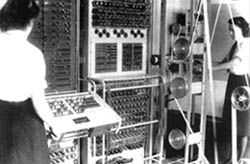 Several times a year, my sister and I spend a weekend away
with our octogenarian parents. We have travelled far and
wide together, but our recent excursion to Bletchley Park,
Woburn and Stowe was our most successful jaunt ever. Several times a year, my sister and I spend a weekend away
with our octogenarian parents. We have travelled far and
wide together, but our recent excursion to Bletchley Park,
Woburn and Stowe was our most successful jaunt ever.
We were joined for our day at Bletchley Park by two uncles,
aged 93 and 95. They and my parents all had wartime memories
of Bletchley, and had friends among the 12,000 who worked
there.
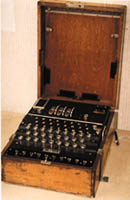 War was declared within days of my father arriving as an
undergraduate at King’s College, Cambridge, and he soon
gathered that many King’s classicists, historians, linguists
and mathematicians – including the eccentric and brilliant
Alan Turing - were working at Bletchley Park. But everyone
knew not to ask questions. Even long after the war, the work
was kept completely secret, and no official recognition was
ever given to the Bletchley boffins whose incredible
intellects secured the Allied victory. War was declared within days of my father arriving as an
undergraduate at King’s College, Cambridge, and he soon
gathered that many King’s classicists, historians, linguists
and mathematicians – including the eccentric and brilliant
Alan Turing - were working at Bletchley Park. But everyone
knew not to ask questions. Even long after the war, the work
was kept completely secret, and no official recognition was
ever given to the Bletchley boffins whose incredible
intellects secured the Allied victory.
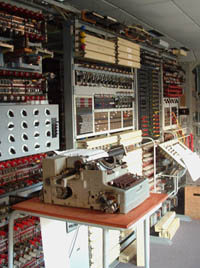 Our guide introduced us to the famous Enigma machine, which
encrypted tactical messages using codes that the Germans
assumed were unbreakable. The machines were the size of
old-fashioned typewriters, with drums, cogs, leads and
lights providing a staggering 158 million million million
possible combinations of letters – codes which were changed
each day. Turing’s ‘bombe’ machines, which deciphered Enigma
messages, looked like large wardrobes, with dozens of dials
on the front, and tangles of plaited cables festooned across
the back. The cryptologists took advantage of minor lapses
by German encryptors, such as repeated messages, stylised
weather reports, messages prefaced with formal greetings, or
the use of swearwords to set the drums. In order to conceal
the extent of the Bletchley operation, Churchill never acted
solely on decoded intelligence, but when complex navy
ciphers were cracked, the Allies were able to intercept
U-boat wolf packs. Our guide introduced us to the famous Enigma machine, which
encrypted tactical messages using codes that the Germans
assumed were unbreakable. The machines were the size of
old-fashioned typewriters, with drums, cogs, leads and
lights providing a staggering 158 million million million
possible combinations of letters – codes which were changed
each day. Turing’s ‘bombe’ machines, which deciphered Enigma
messages, looked like large wardrobes, with dozens of dials
on the front, and tangles of plaited cables festooned across
the back. The cryptologists took advantage of minor lapses
by German encryptors, such as repeated messages, stylised
weather reports, messages prefaced with formal greetings, or
the use of swearwords to set the drums. In order to conceal
the extent of the Bletchley operation, Churchill never acted
solely on decoded intelligence, but when complex navy
ciphers were cracked, the Allies were able to intercept
U-boat wolf packs.
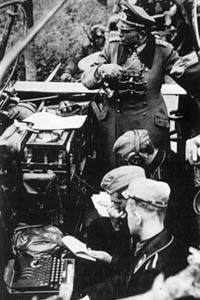 My uncle Wilfrid was captured and imprisoned by the Japanese
in 1942, and was interested to learn how Japanese pictograms
were encrypted and decoded. Classics scholars, accustomed to
tackling tricky ‘unseens’, were given intensive 6-week
courses in Japanese before starting work interpreting
messages. My uncle Wilfrid was captured and imprisoned by the Japanese
in 1942, and was interested to learn how Japanese pictograms
were encrypted and decoded. Classics scholars, accustomed to
tackling tricky ‘unseens’, were given intensive 6-week
courses in Japanese before starting work interpreting
messages.
My other uncle, Theophilus, became friends after the war
with a fellow mathematician called Tutte. They never spoke
about it, but my uncle suspected that Tutte had been a
wartime code-breaker. Our guide became very excited – Bill
Tutte was a star cryptologist at Bletchley, and his famous
Tunny machine, which decoded strategic messages from the
German high command, was on display in one of the huts.
Tutte’s leaps of intuition contributed to the development in
1944 of the Colossus, the world’s first digital computer – a
massive 2500-valve machine which could process 5000 units
per second. Intelligence gleaned via the Colossus confirmed
that Hitler didn’t foresee the D-Day landings in Normandy.
By 1945, there were ten Colossus machines in action, but to
preserve the secret, they were all destroyed after the war.
We peered through a window at a working model, assembled in
1994 in its original position. Wrens, billeted in cold, damp
lodgings, used to dry their laundry around it.
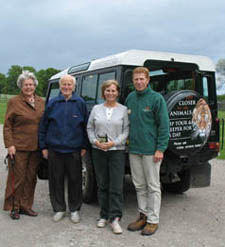 My mother remembered that wartime trains between Oxford and
Cambridge always stopped at Bletchley, and while hundreds of
highly-educated passengers disembarked and embarked there
were sometimes spontaneous concerts on the platform. She
said that everyone knew that something important was going
on there, but nobody said anything. Workers often knew
little apart from their own small roles, and the Official
Secrets Act bound them never to talk. Husbands didn’t tell
wives, wives didn’t tell husbands. A family friend, Diana
Payne, longed to tell her parents about her work on Turing’s
‘bombes’, but she remained silent for 30 years, and her
parents died believing that she had achieved nothing as a
Wren. My mother remembered that wartime trains between Oxford and
Cambridge always stopped at Bletchley, and while hundreds of
highly-educated passengers disembarked and embarked there
were sometimes spontaneous concerts on the platform. She
said that everyone knew that something important was going
on there, but nobody said anything. Workers often knew
little apart from their own small roles, and the Official
Secrets Act bound them never to talk. Husbands didn’t tell
wives, wives didn’t tell husbands. A family friend, Diana
Payne, longed to tell her parents about her work on Turing’s
‘bombes’, but she remained silent for 30 years, and her
parents died believing that she had achieved nothing as a
Wren.
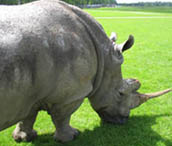 The next day, we visited Woburn, where hundreds of Bletchley
Wrens were billeted. We spent the morning at the safari park
set up by the 13th Duke of Bedford, who inherited the
dilapidated estate after the war. Most visitors to the
safari park bring children, and drive themselves on the
tarmac circuit. We took the VIP option – driving off-road in
a landrover with our own ranger. Although we had all been on
‘real’ safaris abroad, this was a thrilling two-hour tour.
As we drove slowly up to Przewalski’s horses (reintroduced
after becoming extinct in the wild), auburn-coated bongos,
scimitar-horned onyx and two species of zebra, our guide,
Bob, told us how he grew up in India, one of eight children
of missionary parents. The next day, we visited Woburn, where hundreds of Bletchley
Wrens were billeted. We spent the morning at the safari park
set up by the 13th Duke of Bedford, who inherited the
dilapidated estate after the war. Most visitors to the
safari park bring children, and drive themselves on the
tarmac circuit. We took the VIP option – driving off-road in
a landrover with our own ranger. Although we had all been on
‘real’ safaris abroad, this was a thrilling two-hour tour.
As we drove slowly up to Przewalski’s horses (reintroduced
after becoming extinct in the wild), auburn-coated bongos,
scimitar-horned onyx and two species of zebra, our guide,
Bob, told us how he grew up in India, one of eight children
of missionary parents.
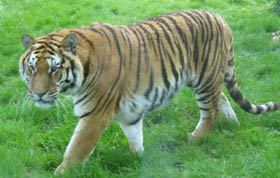
We disembarked to pat two female elephants, and watched as
they plodded off towards their pasture, one trunk linked
companionably into the other’s tail. Leaning out of the
jeep, we touched the mud-caked, leathery skin of white
rhinos as they trotted on incongruously dainty legs. A
scraggy Canadian timber wolf watched us with yellow eyes.
“Much maligned, wolves”, said Bob. “Never been known to kill
a human.” Two feet above us a black bear sprawled in a fork
of a tree. “We don’t go too close to dangerous animals,”
joked Bob, as we parked within a yard of three Siberian
tigers, their thick coats gleaming with health. “They eat a
hundred pounds of meat at a go. That’s like us eating 150
hamburgers.”
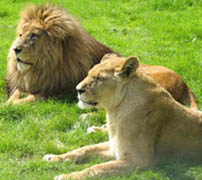
Our vehicle lurched up a steep slope to join a pride of
lions, lounging in the sun – two craggy-faced old brothers,
surrounded by females and year-old cubs, their young bellies
still spotted. Suddenly, inches from my half-open window, a
lioness leapt up to chase a rabbit. Bob pointed to a
handsome young lion, his mane just beginning to grow. “He’s
plotting a takeover.”
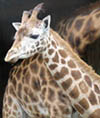
While other visitors made for the crowded cafeterias and
‘walkabout’ area, we drove through Woburn’s verdant deer
park – where ten species of deer graze on 3000 acres - to
the Flying Duchess café, named after the plucky wife of the
11th Duke of Bedford, who took up aviation at the age of 60.
My mother, an avid fan of the BBC Country House series on
Woburn, recognised the 15th Duke as he walked by, and was
full of stories about under-butlers, deer keepers and Lady
T’s customised coffin.
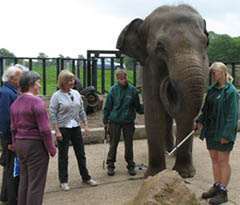 After lunch, we toured the house with a private guide.
Through a series of family portraits, we followed the
history of Woburn, beginning with the 12th century
Cistercian abbey which Henry VIII left in his will to the
first Earl of Bedford, and continuing through 20
generations. A series of advantageous marriages made the
family immensely rich, and Woburn contains one of England’s
finest private art collections, including 24 Canalettos,
purchased from the artist’s studio. The estate once
stretched through East Anglia as far as the Wash, and also
included 100 acres of London. Owning Covent Garden gave the
family a monopoly on providing Londoners with fruit and
vegetables. During the war, the house fell into disrepair
but in 1953, the new Duke knocked down the dampest, most
rotten wings, and restored the rest. Woburn was one of the
first stately homes to welcome visitors. After lunch, we toured the house with a private guide.
Through a series of family portraits, we followed the
history of Woburn, beginning with the 12th century
Cistercian abbey which Henry VIII left in his will to the
first Earl of Bedford, and continuing through 20
generations. A series of advantageous marriages made the
family immensely rich, and Woburn contains one of England’s
finest private art collections, including 24 Canalettos,
purchased from the artist’s studio. The estate once
stretched through East Anglia as far as the Wash, and also
included 100 acres of London. Owning Covent Garden gave the
family a monopoly on providing Londoners with fruit and
vegetables. During the war, the house fell into disrepair
but in 1953, the new Duke knocked down the dampest, most
rotten wings, and restored the rest. Woburn was one of the
first stately homes to welcome visitors.
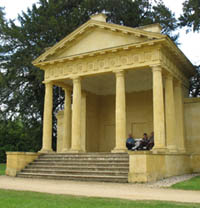
Afternoon tea was invented at Woburn, by Duchess Anna Maria,
wife of the 7th Duke. So, to continue the tradition, we
returned to the Flying Duchess café and ate homemade cakes
and biscuits before returning for a second night at the Inn
at Woburn.
On Sunday, we filled our thermoses with coffee and drove to
Stowe, stopping at the National Trust shop to buy a picnic.
Unlike the nature-loving Dukes of Bedford, Lord Cobham was a
politician, and his gardens make political statements – with
statues of eminent Whigs, royalty and other influential
friends. It was a perfect summer’s day, and we spent several
hours ambling through grassy valleys and copses, through
flower-filled meadows, around lakes, over bridges and past
fountains and waterfalls, stopping to admire each vista
towards pavilion, urn, statue, arch, obelisk or temple.
Capability Brown was head gardener here before his career as
landscaper began. We ate our picnic lunch sitting in one of
Vanbrugh’s twin temples, looking across the Octagonal Lake
(no longer eight-sided but still retaining the name of its
earlier, more formal design). Beyond, the south façade of
Stowe House, designed by Adam, glowed like gold in the
afternoon sunshine. Then we drove home - in time for the 7th
Duchess of Bedford’s favourite meal.
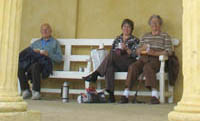 The Inn at Woburn
www.theinnatwoburn.co.uk The Inn at Woburn
www.theinnatwoburn.co.uk
Bletchley Park
www.bletchleypark.org.uk
Woburn Safari Park
www.woburnsafari.co.uk
Woburn Abbey
www.woburnabbey.co.uk
Stowe Landscape Gardens
www.nationaltrust.org.uk
First published by the Telegraph
©SarahShuckburgh |